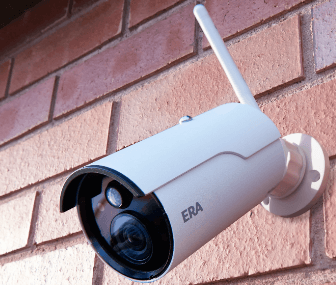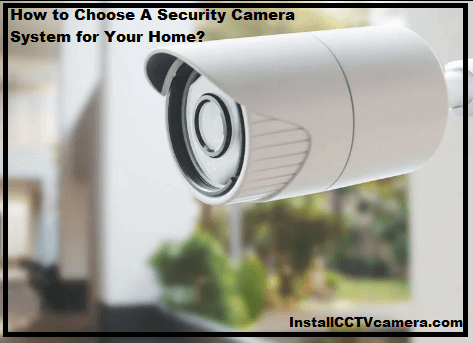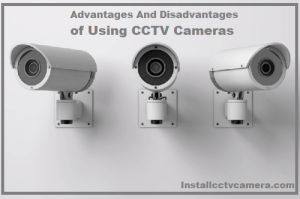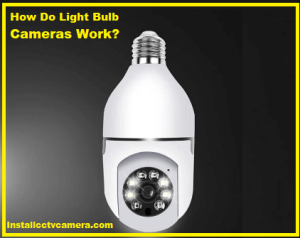When you start looking into a CCTV camera system, there are dozens of things to consider, and you may not understand all the options. Understanding the best security camera system in your home can be overwhelming.
Most individuals don’t realize how many cameras they need for full coverage, get stuck browsing the internet, and often buy a system that can’t provide complete protection.

My goal in this post today is to give you a complete guide to everything you need to consider before making your final decision and purchase when shopping for a CCTV system for your home.
How to Choose A Security Camera System for Your Home?
1. Select the camera type
The type of camera you need depends on where you want to place it. There are many home security camera options if you want one inside your home. To install outside your home, you must decide whether you want a wireless security camera, video doorbell or floodlight camera.
If you want to monitor your front or back door, we recommend using a video doorbell powered through the doorbell wiring. Wireless security cameras are an excellent option to monitor other areas of your property. And if you want to monitor areas with wired floodlights, consider replacing them with floodlit security cameras.
All video doorbell and floodlight cameras are designed to be weatherproof, but not all wireless security cameras are weatherproof. So, if you plan to install it outdoors, check the specifications of the camera you are considering.
2. Night Vision Feature
Choosing the proper night vision security camera can be confusing. There are many factors to consider when deciding whether to prefer colour surveillance or be satisfied with just black and white.
Depending on the circumstances, recording videos in colour at night may be helpful. It can help identify a person’s clothing, car, or general environment. However, colour night vision security cameras require adequate lighting to provide clear images.
It means you may need to set up your lighting environment near your field of view. Many of today’s newer models offer low-light performance features.
This is simply the camera’s ability to detect a small amount of nighttime ambient light, such as a bright moon or nearby street lights, and convert the image to colour.
3. Power selection
Battery-powered security cameras offer the most flexibility for placement inside or outside your home. However, depending on your camera and usage, you must charge it every week to every few months or once or twice a year.
4. Good Resolution
When choosing a camera, it’s important to remember that the higher the MP, the better the camera’s resolution. Choosing a camera resolution may depend on the distance you want to monitor. Cost, storage capacity, and night performance also affect resolution.
Your primary consideration is identifying what you want to cover and how. We recommend 6MP resolution for home setups or 8MP if you live in commercial areas.
5. Cloud storage plans
Before choosing the camera you want, check out how much free cloud storage it comes with and how much extra storage costs. Instead of a memory card, most manufacturers choose cloud storage, where footage is stored remotely on a server, because video files are large and manufacturers can earn extra money through subscriptions.
Without storage, you won’t know if someone is trying to break in if you miss an alert about a potential intruder. Please pay. Free online storage capacity and cost of storage plans can vary significantly by manufacturer and model.
Remember that most plans only store motion-triggered video clips, not continuous video feeds. However, some brands like Arlo and Google Nest offer plans for continuous video storage.
6. AI/motion detection
Security cameras these days not only record what’s happening but can also act as alarms or deterrents using intelligent sensing technology. Most cameras on the market have some rudimentary intelligence, such as motion detection and line-crossing detection.
More standard cameras that rely on pixel-based motion detection tend to activate over the slightest movement. This can send false alerts and make it difficult to view the footage. Active inhibition was developed to address this problem.
It can be designed to send an audible and visual alert to anyone walking in front of the camera within a specified amount of time. They can discriminate between human movements and those of birds in flight and are alert only when necessary. As the name suggests, this is meant to deter potential crime actively.
7. Captures field of view
When choosing a security camera, it is essential to consider the field of view. Most security cameras use fixed focal length lenses to capture an angular field of view, but you can also choose a camera with a variable focal length.
Fixed various lenses are better for focusing on a specific area. As the name implies, the field of view does not change when the camera is fixed in that position. This is best for monitoring entry points or risk areas via counters.
Most regular cameras have fixed lenses. It offers the most expansive field of view at approximately 90° and supports digital zoom only. Since they cover a larger area, they are preferred for more extensive monitoring or more prominent locations.
On the other hand, varifocal lens cameras provide users with multiple angles of a specific area. A varifocal lens allows you to zoom in on a position without reducing the level of resolution. This can be useful if you don’t want to miss any small details.
8. Consider privacy
These cameras offer peace of mind, but it’s worth remembering that they provide a view of your home and connect to the internet. If you can see your house on your phone, you can also glimpse others. Manufacturers also have access to the video.
Remember: Do not use default credentials. Make sure you set up a unique username and hard-to-guess password. More and more cameras offer two-factor authentication, an added layer of security that sends a one-time password via text message, phone call, email, or authenticator app.
When logging in, enter your password, username, and password. This way, even if a hacker cracks your password, they won’t be able to access your camera unless you can access the one-time code.
If your camera offers this feature, you must enable it. These security concerns don’t mean you shouldn’t buy a home security camera. However, if you are concerned about privacy, we recommend not placing these devices in private areas.
Conclusion: Security camera buyers’ Guide
With so many new security camera systems emerging on the market, there is probably one that fits your needs. A little research is needed to get you going. Considering the above factors will let you choose the best one for your home security.
FAQs of Beginner’s Guide to security cameras
What is the difference between a security camera and a surveillance camera?
Security cameras are designed to deter crime and are primarily used for monitoring. Surveillance cameras are usually hidden from the public eye, whereas security cameras are easily visible inside or outside the home and other places.
What are the basics of CCTV cameras?
The primary function of a CCTV camera is to capture light and convert it into a video signal. At the heart of a CCTV camera is a CCD sensor (charge-coupled device). It converts light into an electrical signal. Signal processing converts electrical signals into video signals that can be displayed on a screen or recorded.
What are the four types of CCTV cameras?
- Image result
- Dome cameras
- C mount camera
- Day and night camera.
What are the five elements of CCTV?
When choosing your preferred security system, five components must be considered necessary for consistent service: cameras, monitors, cables, video recorders and data storage.




